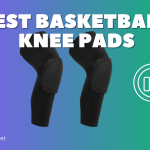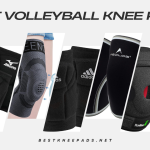Whether you’re an athlete, construction worker, or simply engaging in everyday activities that strain your knees, wearing knee pads is essential for protecting your joints from injury. However, improperly putting on knee pads can result in discomfort and reduced effectiveness. In this section, we will provide you with a step-by-step guide on how to properly put on knee pads for optimal safety and comfort.
Key Takeaways:
- Properly putting on knee pads is crucial for protecting your knees during physical activities.
- Wearing knee pads that do not fit correctly can lead to discomfort and reduced effectiveness.
- Following a step-by-step guide can help ensure your knee pads are positioned correctly, secured in place, and adjusted for a snug fit.
- Choosing the right knee pads and maintaining them properly can also enhance safety and comfort.
- Proper knee preparation can further improve comfort and prevent injury.
Choosing the Right Knee Pads
Before delving into the process of putting on knee pads, it’s essential to choose the right ones for your needs. The right pair of knee pads can make a world of difference when it comes to protection, comfort, and durability. Here are some key factors to consider when selecting knee pads:
Level of Protection
The level of protection offered by knee pads varies greatly, from basic foam padding to heavy-duty hard shell pads. When selecting knee pads, think about the level of protection you need. If you’re engaging in high-impact sports, such as skateboarding or motocross, you’ll likely need a more heavy-duty option. If you’re using them for light construction work or gardening, a softer foam pad may suffice.
Comfort
Comfort is key when it comes to knee pads, especially if you plan to wear them for extended periods. Look for knee pads with breathable materials, such as mesh fabric or perforated foam to prevent excess sweating and discomfort. Also, consider knee pads with adjustable straps to ensure a snug but comfortable fit.
Durability
Durability is also a crucial factor when selecting knee pads. High-quality knee pads are likely to last longer, and therefore, provide better value for your money. Look for knee pads made of durable materials such as neoprene, nylon, or polyurethane. Moreover, inspect for sturdy stitching and reinforced seams to ensure they can withstand wear and tear.
By taking into account these factors, you can select the right knee pads for your needs. Proper knee pad selection is the first step towards ensuring optimal safety and comfort.
Preparing Your Knees
Before putting on knee pads, it’s important to properly prepare your knees to improve comfort and prevent injuries. Here are some tips to help you get ready for your knee pads:
Warm-up your knee joints
Engaging in light aerobic exercises such as walking or cycling can help stimulate blood flow to your knees, preparing them for physical activity. Start with low-intensity exercises and gradually increase the intensity over time. Warming up your knees can help reduce the risk of knee injuries during physical activities.
Perform stretching exercises
Stretching can help improve your knee’s range of motion and flexibility. Practice simple stretching exercises such as quad stretches, calf stretches, and hamstring stretches. Hold each stretch for 20-30 seconds and repeat a few times. Stretching before exercising can help prevent knee pain and injuries.
Apply protective creams or wraps
If you have any existing knee injuries or conditions, consider using protective creams or wraps to provide additional support. These products can help alleviate pain and reduce inflammation, making it easier for you to wear knee pads. Consult with a healthcare provider before using any protective creams or wraps to ensure they’re safe for you to use.
By following these tips, you’ll be able to prepare your knees to wear knee pads comfortably and safely during physical activities.
Putting on Knee Pads Step-by-Step
Now that you’ve selected the right knee pads and prepared your knees, it’s time to put them on!
Step 1: Start by placing the knee pad over your knee cap. Make sure the pad covers your knee cap and extends down towards your shin.
Step 2: Hold the pad in place with one hand and use the other hand to wrap the top strap around your thigh. Fasten the strap securely, but don’t make it too tight.
Step 3: Next, wrap the bottom strap around your calf. Again, make sure it’s secure but not too tight. Adjust the straps if necessary to ensure a comfortable fit.
Step 4: Test the fit by bending your knee and moving around. The knee pad should stay in place and not slide around. If it’s moving, adjust the straps until it’s snug and secure.
Following these steps will ensure your knee pads stay in place and provide the necessary support and protection during physical activity.
Tips for Maintaining Knee Pads
Keeping your knee pads in good condition is essential in ensuring optimal safety and comfort during physical activities. Here are some tips for maintaining your knee pads:
1. Clean them regularly
After each use, wipe your knee pads with a clean cloth to remove any dirt or sweat. For a more thorough clean, you can hand wash them with mild soap and water. Avoid using harsh detergents or putting them in the washing machine, as this can damage the padding.
2. Inspect for wear and tear
Regularly inspect your knee pads for any signs of wear and tear, such as holes or frayed edges. If you notice any damage, it’s best to replace them to ensure continued protection.
3. Store them correctly
When not in use, store your knee pads in a dry and cool place. Avoid leaving them in direct sunlight or damp environments, as this can cause mold or mildew to form.
4. Replace them when necessary
Over time, the padding of knee pads can compress and lose effectiveness. It’s important to replace them when they no longer provide adequate protection or comfort.
5. Follow manufacturer’s instructions
Always refer to the manufacturer’s instructions for specific care and maintenance guidelines. This ensures you’re taking the right steps to properly care for your knee pads and prolong their lifespan.
Conclusion
Properly putting on knee pads is essential for ensuring safety and comfort during physical activities. By choosing the right knee pads, preparing your knees, and following our step-by-step guide, you can minimize the risk of injuries and improve your performance. It’s crucial to maintain your knee pads regularly to ensure they remain in good condition.
Invest in Your Safety and Comfort
Don’t underestimate the importance of knee protection when it comes to physical activities. Taking care of your knees now will benefit you in the long run. Remember, knee pads are not just for athletes, but also for anyone working in construction, gardening, or any other job that involves prolonged kneeling or impact on the knees.
Spread the Knowledge
Share this article with your friends and family members who might benefit from learning how to put on knee pads properly. By spreading the knowledge, you can help others protect their knees and prevent injuries.
Thank you for reading! We hope this article has been informative and helpful.










